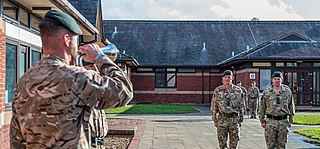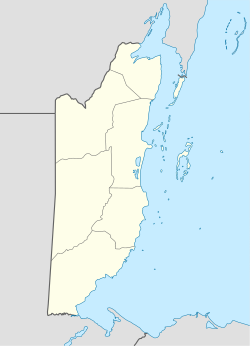
The Belize Defence Force (BDF) is the military of Belize, and is responsible for protecting the sovereignty of the country. The BDF is under the Ministry of National Defence and Border Security, which is currently headed by Hon. Florencio Marin Jr.; the BDF itself is commanded by Brigadier General Azariel Loria. In 2012, the Belizean government spent about $17 million on the military, constituting 1.08% of the country's gross domestic product (GDP).

The Welsh Guards, part of the Guards Division, is one of the Foot Guards regiments of the British Army. It was founded in 1915 as a single-battalion regiment, during the First World War, by Royal Warrant of George V. Shortly after the regiment's formation, it was deployed to France where it took part in the fighting on the Western Front until the end of the war in November 1918. During the inter-war years, the regiment undertook garrison duties in the United Kingdom, except between 1929 and 1930 when it deployed to Egypt, and late 1939 when it deployed to Gibraltar.

The Army Air Corps (AAC) is the aviation arm of the British Army, first formed in 1942 during the Second World War by grouping the various airborne units of the British Army. Today, there are eight regiments of the AAC, as well as two independent flights and two independent squadrons deployed in support of British Army operations around the world. Regiments and flights are located in the United Kingdom, Kenya, and Canada. Some AAC squadrons provide the air assault elements of 16 Air Assault Brigade, through Joint Helicopter Command.
The Devonshire and Dorset Regiment, usually just known as the Devon and Dorsets, was an infantry regiment of the British Army formed in 1958 by the amalgamation of two county regiments, the Devonshire Regiment and the Dorset Regiment. In 2007 it was itself merged into The Rifles, a "large regiment". Members of the regiments referred to themselves as being a Janner.

16 Air Assault Brigade Combat Team, known simply as 16 Air Assault Brigade from 1999 – 2021, is a formation of the British Army predominantly based in Colchester, Essex. It makes up the Air Assault Task Force, a battlegroup held at high readiness, and is the only brigade in the British Army focused on operating via parachute, helicopter and air-landing.

The 7th Light Mechanised Brigade Combat Team is a formation in the British Army with a direct lineage to 7th Armoured Brigade and a history that stretches back to the Napoleonic Wars. It saw active service in the Crimean War, the Second Boer War and both the First and the Second World Wars. In 2014, the 7th Armoured Brigade was re-designated as 7th Infantry Brigade, thereby ensuring that the famed "Desert Rats" continue in the British Army's Order of battle.

The 1st Armoured Infantry Brigade was an infantry brigade of the British Army with a long history including service during both the First and the Second World Wars. It was based at Tidworth Camp. Previously, it has been designated 1st (Guards) Brigade, 1st Infantry Brigade, 1st Mechanised Brigade, and under the initial Army 2020 reforms assumed the title of 1st Armoured Infantry Brigade. Under the Future Soldier programme, the brigade merged with the 1st Artillery Brigade to form the 1st Deep Recce Strike Brigade Combat Team.

Colchester Garrison is a major garrison located in Colchester in the county of Essex, eastern England. It has been an important military base since the Roman era. The first permanent military garrison in Colchester was established by Legio XX Valeria Victrix in AD 43, following the Roman conquest of Britain. Colchester was an important garrison town during the Napoleonic Wars and throughout the Victorian era. During the First World War, several battalions of Kitchener's Army were trained there.

The 20th Armoured Brigade Combat Team, previously the 20th Armoured Infantry Brigade, is an armoured infantry brigade formation of the British Army, currently headquartered at Wing Barracks, Bulford, Wiltshire, as part of the 3rd Division.

Aldershot Garrison, also known as Aldershot Military Town, is a major garrison in South East England, between Aldershot and Farnborough in Hampshire. The garrison was established when the War Department bought a large area of land near the village of Aldershot, with the objective of establishing a permanent training camp for the Army. Over time, this camp grew into a military town and continues to be used by the Army to the present day. It is home to the headquarters of the Army's Regional Command and Home Command, and it is also the headquarters for the Army Special Operations Brigade. The garrison plays host to around 70 military units and organisations.

Bulford Camp is a military camp on Salisbury Plain in Wiltshire, England. Established in 1897, the site continues in use as a large British Army base. The camp is close to the village of Bulford and is about 2+1⁄4 miles (3.6 km) north-east of the town of Amesbury. The camp forms part of the Tidworth, Netheravon and Bulford (TidNBul) Garrison.

The Nigerian Army (NA) is the land force of the Nigerian Armed Forces. Tracing its history to British colonial forces in West Africa, it is the largest component of the armed forces. The President of Nigeria is the Commander-in-Chief of the Nigerian Army, and its professional head is the Chief of Army Staff, who is the highest ranking military officer of the Nigerian Army. It is governed by the Nigerian Army Council (NAC). The Nigerian Army is operationally and geographically divided into ten divisions, the basic field formation. The army has been involved in operations throughout the country, most especially during the Nigerian Civil War, and has undertaken major operations abroad. Nigerian Army officers have served as chiefs of defence in other countries, with Brigadier General Maxwell Khobe serving as Sierra Leone chief of staff in 1998–1999, and Nigerian officers acting as Command Officer-in-Charge of the Armed Forces of Liberia from at least 2007.

The 1st Signal Brigade, formerly known as the 1st Signal Group, is a brigade of the British Army. The group was first formed in 1968 as a result of the 1966 Defence White Paper which expanded support for NATO and the British Army of the Rhine. In 1987, the group was disbanded and merged into the 2nd Signal Brigade. In 1995, the brigade was reformed and has since deployed on operations across the globe in support of NATO and HQ Allied Rapid Reaction Corps.

Queen Elizabeth Barracks is a British Army installation in Strensall, North Yorkshire, England. It opened in the 1880s, and since 2016, it has been under threat of closure, but was reprieved in 2024.

8th Engineer Brigade is an engineering support formation of the British Army, which forms part of 1st Division.

The 1st Military Police Brigade is a policing formation of the British Army, which is the only one-star command of the Royal Military Police. The brigade was formed in 2014 and is commanded by a brigader, but is due to be re-structured and reduced to a colonel's command.

British Army Training Support Unit Belize (BATSUB), the successor of the former British Forces Belize, is the name given to the current British Army Garrison in Belize. The garrison is used primarily for jungle warfare training, with access to over 13,000 square kilometres (5,000 sq mi) of jungle terrain, provided by the Government of Belize.

The page contains the current structure of the British Army. The British Army is currently being reorganised to the Future Soldier structure.

The Battle of Orange Walk took place on 1 September 1872 when a force of Icaiche Maya led by Marcus Canul attacked the town of Orange Walk in Belize. Canul had previously been involved in conflict with the British authorities over infringements of his people's land rights and non-payment of rent and one motive for the raid may have been to seize the district magistrate for ransom. Canul and his men crossed the border from Mexico the day before the battle and were able to reach the town undetected by the British. They launched a surprise attack that caught the small garrison unaware – the British commanders were in the bath at the time the battle started. The British forces – a small detachment of the West India Regiment – successfully defended their barracks building for a number of hours, inflicting heavy casualties on the Maya and fatally wounding Canul. The Maya then withdrew into Mexico.



















